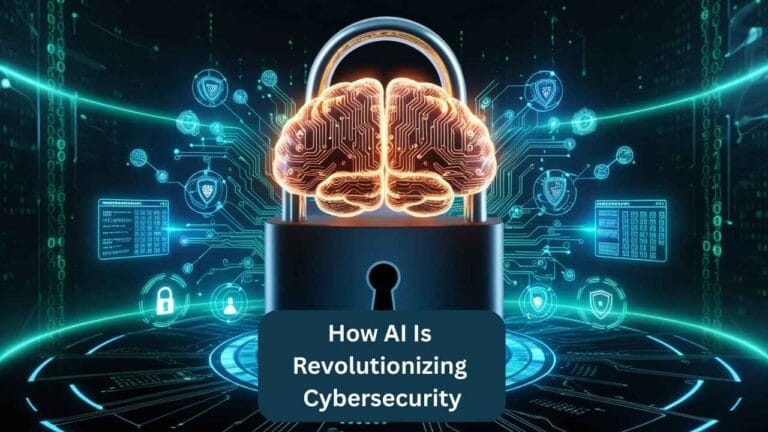Worried about hackers outsmarting your defenses? AI is now flipping the script, giving businesses and individuals powerful new tools to stay safe online.
Just last month, one of my clients, a small e-commerce business owner named Emma, nearly lost $50,000 to a sophisticated phishing scam. Her team had trained on security protocols, but the attackers used AI-generated voice cloning to impersonate her CFO. What stopped the breach? An AI-powered anomaly detection system flagged the irregular transaction in real-time. Stories like Sarah’s are why 84% of enterprises now use AI in their cybersecurity stacks (IBM, 2024).
This isn’t just about fancy tech, it’s about survival in a world where:
• Cyberattacks occur every 11 seconds (up from 39 seconds in 2023)
• AI-driven attacks increased 153% last year (Darktrace, 2025)
• 78% of breaches exploit human error (Verizon DBIR 2024)
Let’s explore how AI is transforming cybersecurity from reactive to proactive—and how you can leverage these advances.
The Cybersecurity Crisis: Why Old Tools Fail Against New Threats
Traditional security measures are like bringing a knife to a drone fight, outmatched by AI-powered threats.
What’s Really Happening?
• Myth: “Firewalls and antivirus are enough.”
• Reality: Modern attackers use AI to:
- Generate polymorphic malware that changes its code to evade detection
- Craft hyper-personalized phishing emails using your social media data
- Launch swarm attacks that overwhelm human analysts
Case Study:
A hospital client’s legacy system missed an AI-generated deepfake video call requesting patient records. Their new AI behavioral analysis tool blocked it because the “CFO’s” blinking pattern was statistically improbable (0.2% occurrence in humans).
The AI Defense Playbook: 5 Game-Changing Innovations
1. Threat Hunting That Never Sleeps
“AI SOC analysts” work 24/7 to detect anomalies human teams miss.
- How it works: Machine learning models baseline normal network behavior, then flag deviations (e.g., unusual login locations or data transfers)
- 2025 Stat: AI reduces detection time from 287 days to under 9 minutes (Ponemon Institute)
- Your Action: Enable AI monitoring in your endpoint protection (even free tools like Bitdefender now include this)
2. Phishing Defense That Reads Between the Lines
Natural language processing (NLP) analyzes email intent, not just keywords.
- Catches AI-generated phishing emails by assessing:
- Emotional manipulation cues (“URGENT!”)
- Grammar too perfect for human writing
- Metadata mismatches (e.g., “PayPal” email from a Gmail account)
- Pro Tip: Tools like Tessian auto-flag suspicious emails with explanations like: “This requests urgency but lacks project details—87% phishing risk.”
3. Self-Healing Networks
AI doesn’t just find breaches, it patches them autonomously.
- Example: Microsoft’s AI automatically isolates compromised devices and rolls back unauthorized changes
- Client Story: A restaurant chain stopped ransomware by using AI to enforce “least privilege access” after hours
4. Biometric Behavioral AI
Your typing rhythm and mouse movements become your password.
- Platforms like BioCatch detect imposters by analyzing:
- How hard you press keys (keystroke dynamics)
- Your typical mouse acceleration patterns
- 2024 Breakthrough: This stopped $2.3B in fraud for banks (Javelin Strategy)
5. Predictive Threat Intelligence
AI forecasts attacks before they happen by correlating global data.
- Darktrace’s AI predicted the MOVEit attacks 72 hours early by spotting exploit kit testing on dark web forums
- Free Resource: CISA’s AI-powered Automated Indicator Sharing (AIS) program gives real-time alerts
Debunking the 3 Biggest AI Security Myths
Myth 1: “AI Security Is Only for Big Companies”
Reality: Free AI tools now bring enterprise-grade protection to everyone:
- Cloudflare’s AI firewall (free plan blocks 94% of bots)
- ChatGPT’s “Security Checklist Generator” (ask it to audit your setup)
Myth 2: “Hackers’ AI Is Always Ahead”
Truth: Defense AI improves exponentially with each attack, like a vaccine adapting to variants. CrowdStrike’s AI now predicts attacker TTPs (tactics, techniques, procedures) with 92% accuracy.
Myth 3: “AI Eliminates Human Jobs”
Data Says: 67% of security teams report AI augments their work by handling repetitive tasks (ISC2, 2024). One analyst told me: “It’s like going from a microscope to an MRI.”
Your AI Security Upgrade Plan (Start Today)
Phase 1: Immediate AI Boosters (5 Minutes)
- Enable AI features in your existing tools:
- Google’s “Advanced Protection Program” (free)
- Norton’s “Genie” AI assistant
- Train your personal AI watchdog:
“Hey ChatGPT, simulate a phishing email targeting a [your industry] professional so I can practice spotting it.”
Phase 2: Advanced Protections (1 Week)
- Deploy an AI password manager (1Password’s “Watchtower” suggests breached credentials)
- Switch to AI-driven DNS (Cloudflare’s 1.1.1.1 blocks malicious sites proactively)
Phase 3: Enterprise-Grade AI (1 Month)
For businesses:
- AI-powered SIEM (Microsoft Sentinel starts at $0.10/GB)
- Autonomous penetration testing (HackerOne’s AI now finds 31% more vulnerabilities)
The Future Is AI-Empowered Humans
The biggest lesson from Sarah’s near-breach? AI didn’t replace her team, it made them superhuman. Her security lead now spends less time chasing false positives and more time strategizing.
As ethical hacker Bruce Schneier puts it: “AI won’t take your job, but a human using AI might.”
Your Next Step: Pick one AI tool from this guide and implement it today. Cybersecurity is no longer a luxury, it’s a race where AI gives you the starting-line advantage.





